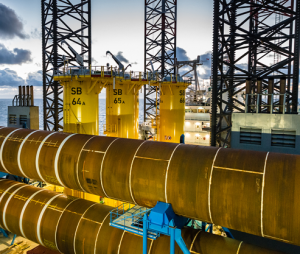TWD proved higher MP friction
 Over the course of the last years, TWD developed an advanced friction measurement method and probabilistic verification of monopile stability during transit. Both have now received certification from DNVGL.
Over the course of the last years, TWD developed an advanced friction measurement method and probabilistic verification of monopile stability during transit. Both have now received certification from DNVGL.
This sets a new standard in monopile seafastening. The optimised methodology results in the ability to increase workability by 20-50% whilst maintaining the highest safety standards. In collaboration with TU Delft University of Technology, TWD engineers conducted different friction tests at the Laboratory of Aerospace Engineering to develop the DNVGL-certified probabilistic verification method of the stability of monopiles. This method combines a verified tailor-made static friction test set-up, calculation methods according to industry standards and advanced insights in the variability of the coefficient of friction at the interfaces.
Seafastening large diameter monopiles on heavy lift installation vessels becomes an ever-increasing challenge. One of the main design challenges is verification of monopile stability on the friction-based interface at its supports. Monopiles have different coating and different surface roughness and so do the interfaces where they are positioned. With this now certified method, the company’s engineers can work with optimised friction coefficients, making the designs safer and more cost-effective. TWD will use this method in future projects in transatlantic transport in Asia and in offshore installation at the French coast, where weather conditions are rougher than in the North Sea. The offshore wind industry ventures into unexplored territories where more severe environmental conditions become the new standard. TWD’s verification method and friction test set-up will be crucial to guarantee the integrity and stability of monopiles, also in higher sea states. Learn more on https://twd.nl/twd-proved-higher-mp-friction/ .
(advertorial)






